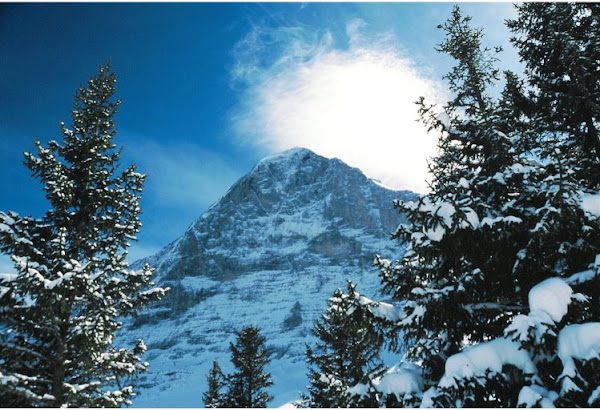 Yesterday there was some more fresh snow, with the sun coming out in the afternoon. The off piste was fantastic, powder up to my knees. The pistes were beautiful, and empty.
Yesterday there was some more fresh snow, with the sun coming out in the afternoon. The off piste was fantastic, powder up to my knees. The pistes were beautiful, and empty.Today, however the Foehn wind is due to appear again. In the micro cosmos of the Jungfrau region the Foehn is a frequent visitor. This phenomenon occurs on the lee side of a mountain, which is us. The wind comes up against the mountains, from the south, as it ascends it cools producing precipitation and with it the common cloud formations. On it’s descent it speeds up and warms up. A temperature increase of as much as 30 °C has been recorded and can lead to an amazing disappearance of the snow. After a Foehn storm the Lauberhorn piste can be rather glassy and bare. Not a very nice surface to ski on.
These gusts of wind can reach high speeds. The chair lifts have to be slowed and usually stopped, otherwise the cable could be hooked off the rollers or a chair swung into the pylon. It has been known for a train to be derailed, especially when empty. Hence the trains stop running.
This wind comes from the south and sometimes it brings with it the Sahara sands. Everything then has a slight yellow tinge.
In the Pennine this wind is known as the Helm, in Ticino, Italy as Favonio, as the Terral in Malaga, as the Nor’wester in Hawkes Bay New Zealand and as the Chinook winds in the Rocky Mountains.
These gusts of wind can reach high speeds. The chair lifts have to be slowed and usually stopped, otherwise the cable could be hooked off the rollers or a chair swung into the pylon. It has been known for a train to be derailed, especially when empty. Hence the trains stop running.
This wind comes from the south and sometimes it brings with it the Sahara sands. Everything then has a slight yellow tinge.
In the Pennine this wind is known as the Helm, in Ticino, Italy as Favonio, as the Terral in Malaga, as the Nor’wester in Hawkes Bay New Zealand and as the Chinook winds in the Rocky Mountains.



No comments:
Post a Comment